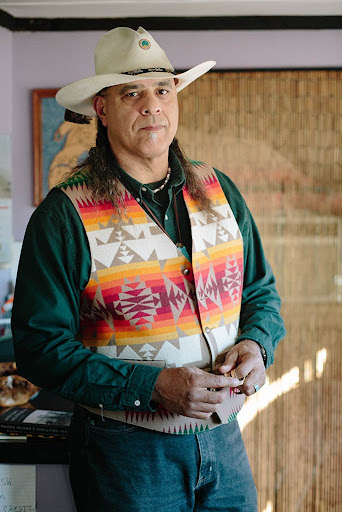
A stretch of sandy beach. Opaque turquoise waves illuminated by waning fall sun. A gentle cold breeze ripples through the quiet air, the quietness of no paved roads, no cars, no buildings. Young members of the Narragansett tribe roam under the blue sky, fluffy cumulus clouds and the waving leaves of orange trees their only highrise. They are searching for Popuauhok, modern day quahogs or clams. Inside their calcium rich, chalky shells lies a nutrient dense pocket of muscle that can be eaten. The spongey, firm tongue of the clam is roasted or steamed, ground into powder, or celebrated in a clam bake (layers of live clams steamed over a pit layered with seaweed). After the meat is harvested, their shells lay open, broken, like the discarded pages of books torn from the stem. A small streak of iris catches the attention of one of the Narragansett. He reaches a long, athletic arm down to the sand, a smile illuminates his face. The shell is ringed with a wall of the most beautiful purple color he has seen yet. He joyfully pockets the shell, knowing how excited his father will be to use this for his wampum.
Allen Hazard’s store, The Purple Shell, sits tucked away in the magical bamboo forests and crushed shell streets of the Charlestown Umbrella Factory. I spoke to Hazard over the phone, as he was up at his place in New Hampshire for the next few weeks. Something his store-front neighbor, Block Prints, laughed at: “Of course he is. I’ve known Allen for years, he’s a great, great guy.” Hazard’s voice was welcoming, slow, patient. The cadence of an artist who is used to spending long periods of time dedicated to making beautiful things. “I carry a lot of pride in being a Narragansett,” says Hazard. “What I do is a big part of the tradition, it goes back further than any nationality. Wampum is just plain beautiful.”

The Indigenous practice of making wampum is turning the streaks of purple from the quahog shell into pieces of jewelry or beads. There is a narrative that wampum was used as money, which Hazard quickly retaliates against. “It was always something we were saying, the beautiful color we had around us after the meal. This color was what got the Europeans saying, ‘it’s Indian money,’ which is horribly wrong. They saw us giving it to each other and thought we were paying for things, but we were giving each other beautiful things.” Hazard elaborates, “A gift from our creators. We all view it, and we all smile.”
Hazard’s aunt Laura inspired him to carry on the tribal tradition of wampum art. She was a beader, a loom worker, who impressed him greatly with her work. When she opened a small store for her artwork in her house out of Wakefield, it was his first inkling that he might one day want to do something like her. He started his business in a similar fashion, out of his basement. Eventually, after the owner of the Umbrella Factory visited him three times, he accepted the offer to move his store there. “It’s nice to get the overflow of people who don’t know what wampum is. If nothing else, it’s a museum for people who don’t have a clue.”
The attitude Hazard has towards his artwork is not focused on monetary gain but is motivated by an urge to “keep the old ways alive.” He speaks of his seven-year-old granddaughter, who during their walks on the beach will run up to him with a shell, sparkling with purple, and say, “Papa look, wampum!”
“What makes it special is that this young girl, as she gets older, will carry on this tradition. That’s the same thing for my whole nation. Every generation after me must take the old ways and keep it alive.”
Correcting misrepresented history is important, and if people like Hazard do not continue to carry it through their lives and the lives of their young, traditional art will, and would have already been, swallowed by European narratives.
The future, as we enter the age of artificial intelligence and advancing capitalistic enterprises, does not frighten Hazard. The scars of history run deep, and retribution pales in comparison to atrocity. “Only a few of us Eastern Nations could maintain a reservation on the ocean, wampum is from the ocean front. Not from the rivers and swamps we are chained to. We still do what the government tells us to do to get along better. As the years go on it’s the government’s hope that we forget about where we came. It’s the horrific reality that what’s taken is taken and will never be given back. But if I teach my children and grandchildren the traditions of the Narragansett, none of that will matter.” •
The Purple Shell is located at 4820 Old Post Rd, Charlestown.
For more information, visit fb.com/thepurpleshellgifts or call (401) 364-8088.